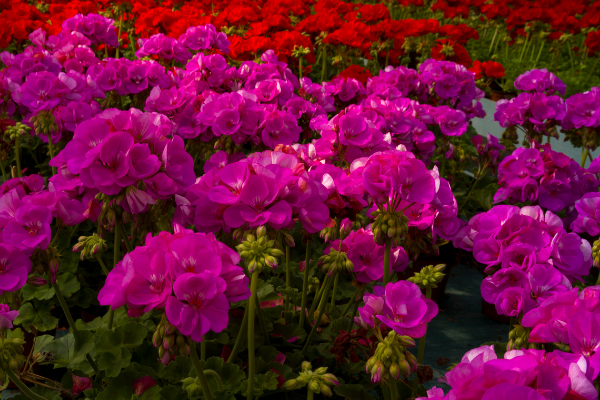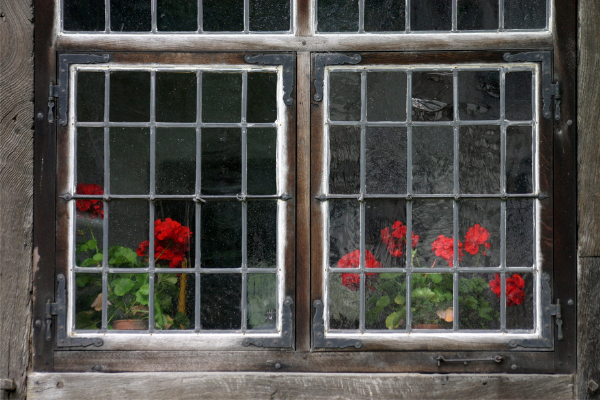In Andalusia it is not difficult to find balconies, terraces, gardens and patios, where Pelargoniun zonale are the protagonists these days, but their use expands to any place where the sun shines and frosts are not frequent.
For us, the contribution of geraniums to summer days is joy and colour. That’s why they are part of our garden – it couldn’t be any other way!
Here is a summary of their care, which is very simple. If you follow these simple tips, you will enjoy healthy and colourful flowers.
A geranium needs light. With a minimum of 6 hours of direct sun you will get an enviable flowering, but be careful, we advise you to put it in the shade in the afternoon. This will help to keep its leaves bright green and its buds from being overexposed to the high summer temperatures.
Watering is no less important. We may have kept our geraniums during the winter months with little humidity, but as flowering begins, it is necessary to increase watering as well, especially in these hot months when they are at their most spectacular. It is advisable to water it a couple of times a week, although it will depend on the hours of sunlight it receives, the ventilation, the type of substrate it has (we recommend that it is well drained), etc.
But there is more to tell: over-watering will only have negative consequences for your geraniums. Their roots tend to rot with an excess of humidity. Furthermore, their dark green leaves can turn yellow as a result of excess moisture.
Oh! So, what is the middle ground?
Don’t worry!
The key is to keep the substrate slightly moist and to check it before watering again, that is. only water when it dries out.
In order to get a great bloom, I advise you to prune the flowers that are drying out to give them a chance to sprout again, as well as the stems that are extremely long and that detract from the plant’s vigour.

We are now talking about the fertilisation of flowering plants, as they need a little more resources than non-flowering plants. The substrates used in production usually contain slow-release fertilisers to support the plants in their development during the first 6 months to 1 year after purchase. However, a little help from us at times of growth or flowering is always welcome.
Buying fertiliser for flowering plants from a reputable garden centre will be enough for our geraniums to give us an explosion of colour after a few weeks. We advise you to do this in spring, which is when the plant starts to get its energy going, and in this case. However, if you have lost your way a little, you can use liquid fertiliser during the summer weeks. One dose per month is usually sufficient and has practically the same result.
When temperatures are warm, around 20°C to 22°C, our geraniums can be attacked by the geranium butterfly or “cacyreus marshalli”. The life cycles of this insect can have up to 5 or 6 generations per season, so you need to keep an eye on them from spring until the cold weather sets in.
There are four phases in its life cycle:
The butterfly will lay eggs. These eggs will hatch and we will have caterpillars on our geraniums. This caterpillar will feed on the tender shoots of the leaves of the plant and as it grows, it will perforate the stems and begin to bore or drill into them. These caterpillars will become larger, approaching the chrysalis stage, from which a butterfly will emerge and start the cycle all over again.
The damage to the plant is obvious. You will notice it when you see bites on the leaves. Soon after, you will detect small holes in the trunks, where the caterpillars live, which are also the gateway for bacteria and fungi that will further weaken the plant.
If the main trunk has been affected, it is best to get rid of that plant as soon as possible so as not to infect the rest. If you start to detect the problem, the best option is to buy an insecticide containing 10% “cypermethrin”. This usually acts by ingestion and contact, and is very effective at low doses.
How to apply the insecticide? To prevent an attack, it is advisable to apply it every 2 or 3 weeks. For disinfection by invasion, I recommend spraying after 7 days at the latest.
Finally, it is time for pruning.
The key to flowering next year is the autumn pruning. We recommend to prune it to a third of its volume and at the same time, put the solid fertilizer, which will provide the nutrients consumed in this past period of maximum flowering.
Remember that geraniums need a temperature between 18-20°C to feel good. When temperatures drop, keep it indoors, in a window where it receives direct light, or use thermal blankets to protect it from winter frosts.

We would be delighted if you put into practice the little tips we have given you and decide to include this variety among your flowers. Few plants are so grateful with so little care and you will bring an Andalusian touch to your home, wherever you live.
At Rachel&Co, your geraniums are available until July.
Until our next meeting, where we will continue sharing our love for plants with you!


